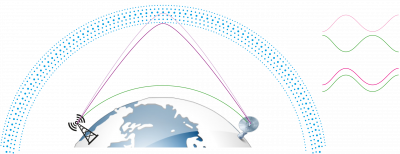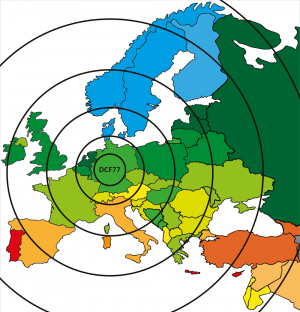Long Wave Signal Reception
A number of countries are operating long wave transmitters which broadcast the current time and eventually some additional information via a long wave signal. Examples are
- DCF-77 in Germany
- WWVB in the United States
- MSF in UK
- JJY in Japan
In many cases the long wave signal can be received inside buildings, and receivers are cheap, so they can easily be integrated into wall clocks, etc. However, the possible accuracy is usually limited to one or a few milliseconds, which is mainly due to the typical characteristics of long wave signals in general, and the limited bandwidth available for transmission.
The limited bandwidth together with noise filtering in the receiver makes it hard to determine the point of time of a certain time mark very accurately. The graph below shows an example of a received long wave signal with narrow bandwidth (top) and broad bandwidth (bottom):

While a narrow bandwidth is better to suppress electrical noise, the slopes of the demodulated time marks become much flatter, and thus the beginning of a time mark can only be determined less accurately than with broad bandwidth and steeper slopes. However, in the presence of electrical noise even a steep slope is hard to be determined very accurately.
At least if accuracies better than 1 millisecond are required then the propagation delay of the radio frequency (RF) signal needs to be determined and compensated in the receiver. However, a long wave receiver is unable to determine the propagation delay by itself since usually only the signal from a single transmitter can be received. So the receiver can't find out how long the signal has been propagating before it arrived at the receiving location.
A basic problem with long wave signals is that there is a ground wave signal which propagates along the surface of the globe, and a sky wave which is reflected at the ionosphere, as shown in next graph:

The ground wave signal is strong at distances up to a few 100 kilometers around the transmitter, but at distances beyond this the wave reflected at the ionosphere dominates, and obviously the way the reflected wave has taken is significantly longer than the direct way along the globe's surface. So even if you try to compute the geographic distance of the receiver from the transmitter to compensate the propagation delay, the resulting accuracy depends on whether the ground wave or the sky wave is stronger at the location of the receiver.
Things get even worse if you take into account that the height of the ionosphere over ground varies with the season, the weather, and the time of day. This lets the real distance of the reflected long wave signal vary slowly over time. At distances from the transmitter where the ground wave and the sky wave arrive with a similar signal strength the variation of the sky wave's signal path causes a phase shift of the sky wave signal relative to the ground wave signal, which in turn causes an interference between the two signals which in worst case leads to a cancellation of the combined signal whenever the phase shift is about 180°. As a result, reception may temporarily not be possible at all in the regions with the affected distance from the transmitter.
Long wave signals can only be received up to a certain distance from the transmitter, so another limitation is that these receivers can't be used world-wide. The graph below shows the useable range of the DCF-77 transmitter in Germany:

An estimation of the WWVB’s coverage is available at the NIST web site:
- WWVB Coverage Area
https://tf.nist.gov/stations/wwvbcoverage.htm
Time signals provided by long wave transmitters use only very simple modulation and encoding schemes, so they can easily be jammed, i.e. reception can be disrupted, or spoofed, which is even worse since a wrong time can be supplied to receivers.
— Martin Burnicki 2016-08-04 14:29